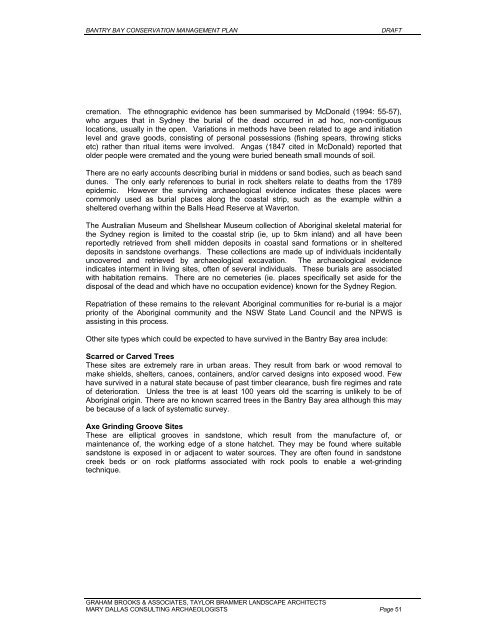Bantry Bay (Garigal National Park) - Department of Environment and ...
Bantry Bay (Garigal National Park) - Department of Environment and ...
Bantry Bay (Garigal National Park) - Department of Environment and ...
Create successful ePaper yourself
Turn your PDF publications into a flip-book with our unique Google optimized e-Paper software.
BANTRY BAY CONSERVATION MANAGEMENT PLAN<br />
DRAFT<br />
cremation. The ethnographic evidence has been summarised by McDonald (1994: 55-57),<br />
who argues that in Sydney the burial <strong>of</strong> the dead occurred in ad hoc, non-contiguous<br />
locations, usually in the open. Variations in methods have been related to age <strong>and</strong> initiation<br />
level <strong>and</strong> grave goods, consisting <strong>of</strong> personal possessions (fishing spears, throwing sticks<br />
etc) rather than ritual items were involved. Angas (1847 cited in McDonald) reported that<br />
older people were cremated <strong>and</strong> the young were buried beneath small mounds <strong>of</strong> soil.<br />
There are no early accounts describing burial in middens or s<strong>and</strong> bodies, such as beach s<strong>and</strong><br />
dunes. The only early references to burial in rock shelters relate to deaths from the 1789<br />
epidemic. However the surviving archaeological evidence indicates these places were<br />
commonly used as burial places along the coastal strip, such as the example within a<br />
sheltered overhang within the Balls Head Reserve at Waverton.<br />
The Australian Museum <strong>and</strong> Shellshear Museum collection <strong>of</strong> Aboriginal skeletal material for<br />
the Sydney region is limited to the coastal strip (ie, up to 5km inl<strong>and</strong>) <strong>and</strong> all have been<br />
reportedly retrieved from shell midden deposits in coastal s<strong>and</strong> formations or in sheltered<br />
deposits in s<strong>and</strong>stone overhangs. These collections are made up <strong>of</strong> individuals incidentally<br />
uncovered <strong>and</strong> retrieved by archaeological excavation. The archaeological evidence<br />
indicates interment in living sites, <strong>of</strong>ten <strong>of</strong> several individuals. These burials are associated<br />
with habitation remains. There are no cemeteries (ie. places specifically set aside for the<br />
disposal <strong>of</strong> the dead <strong>and</strong> which have no occupation evidence) known for the Sydney Region.<br />
Repatriation <strong>of</strong> these remains to the relevant Aboriginal communities for re-burial is a major<br />
priority <strong>of</strong> the Aboriginal community <strong>and</strong> the NSW State L<strong>and</strong> Council <strong>and</strong> the NPWS is<br />
assisting in this process.<br />
Other site types which could be expected to have survived in the <strong>Bantry</strong> <strong>Bay</strong> area include:<br />
Scarred or Carved Trees<br />
These sites are extremely rare in urban areas. They result from bark or wood removal to<br />
make shields, shelters, canoes, containers, <strong>and</strong>/or carved designs into exposed wood. Few<br />
have survived in a natural state because <strong>of</strong> past timber clearance, bush fire regimes <strong>and</strong> rate<br />
<strong>of</strong> deterioration. Unless the tree is at least 100 years old the scarring is unlikely to be <strong>of</strong><br />
Aboriginal origin. There are no known scarred trees in the <strong>Bantry</strong> <strong>Bay</strong> area although this may<br />
be because <strong>of</strong> a lack <strong>of</strong> systematic survey.<br />
Axe Grinding Groove Sites<br />
These are elliptical grooves in s<strong>and</strong>stone, which result from the manufacture <strong>of</strong>, or<br />
maintenance <strong>of</strong>, the working edge <strong>of</strong> a stone hatchet. They may be found where suitable<br />
s<strong>and</strong>stone is exposed in or adjacent to water sources. They are <strong>of</strong>ten found in s<strong>and</strong>stone<br />
creek beds or on rock platforms associated with rock pools to enable a wet-grinding<br />
technique.<br />
GRAHAM BROOKS & ASSOCIATES, TAYLOR BRAMMER LANDSCAPE ARCHITECTS<br />
MARY DALLAS CONSULTING ARCHAEOLOGISTS Page 51
















